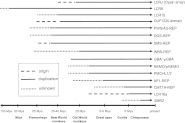Evolution in health and medicine Sackler colloquium: Genomic disorders: a window into human gene and genome evolution
- PMID: 20080665
- PMCID: PMC2868291
- DOI: 10.1073/pnas.0906222107
Evolution in health and medicine Sackler colloquium: Genomic disorders: a window into human gene and genome evolution
Abstract
Gene duplications alter the genetic constitution of organisms and can be a driving force of molecular evolution in humans and the great apes. In this context, the study of genomic disorders has uncovered the essential role played by the genomic architecture, especially low copy repeats (LCRs) or segmental duplications (SDs). In fact, regardless of the mechanism, LCRs can mediate or stimulate rearrangements, inciting genomic instability and generating dynamic and unstable regions prone to rapid molecular evolution. In humans, copy-number variation (CNV) has been implicated in common traits such as neuropathy, hypertension, color blindness, infertility, and behavioral traits including autism and schizophrenia, as well as disease susceptibility to HIV, lupus nephritis, and psoriasis among many other clinical phenotypes. The same mechanisms implicated in the origin of genomic disorders may also play a role in the emergence of segmental duplications and the evolution of new genes by means of genomic and gene duplication and triplication, exon shuffling, exon accretion, and fusion/fission events.
Conflict of interest statement
The authors declare no conflict of interest.
Figures



References
-
- Lupski JR. Genomic disorders: Structural features of the genome can lead to DNA rearrangements and human disease traits. Trends Genet. 1998;14:417–422. - PubMed
Publication types
MeSH terms
LinkOut - more resources
Full Text Sources
Other Literature Sources

